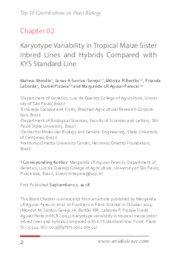Karyotype variability in tropical maize sister inbred lines and hybrids compared with kys standard line.
Karyotype variability in tropical maize sister inbred lines and hybrids compared with kys standard line.
Author(s): MONDIN, M.; SEREJO, J. A. dos S.; BERTÃO, M. R.; LABORDA, P.; PIZZAIA, D.; AGUIAR-PERECIN, M. L. R.
Summary: Maize karyotype variability has been extensively investigated. The identification of maize somatic and pachytene chromosomes has improved with the development of fluorescence in situ hybridization (FISH) using tandemly repeated DNA sequences as probes. We identified the somatic chromosomes of sister inbred lines that were derived from a tropical flint maize population (Jac Duro [JD]), and hybrids between them, using FISH probes for the 180-bp knob repeat, centromeric satellite (CentC), centromeric satellite 4 (Cent4), subtelomeric clone 4-12-1, 5S ribosomal DNA and nucleolus organizing region DNA sequences. The observations were integrated with data based on C-banded mitotic metaphases and conventional analysis of pachytene chromosomes. Heterochromatic knobs visible at pachynema were coincident with C-bands and 180-bp FISH signals on somatic chromosomes, and most of them were large. Variation in the presence of some knobs was observed among lines. Small 180-bp knob signals were invariant on the short arms of chromosomes 1, 6, and 9. The subtelomeric 4-12-1 signal was also invariant and useful for identifying some chromosomes. The centromere location of chromosomes 2 and 4 differed from previous reports on standard maize lines. Somatic chromosomes of a JD line and the commonly used KYS line were compared by FISH in a hybrid of these lines. The pairing behavior of chromosomes 2 and 4 at pachytene stage in this hybrid was investigated using FISH with chromosome-specific probes. The homologues were fully synapsed, including the 5S rDNA and CentC sites on chromosome 2, and Cent4 and subtelomeric 4-12-1 sites on chromosome 4. This suggests that homologous chromosomes could pair through differential degrees of chromatin packaging in homologous arms differing in size. The results contribute to current knowledge of maize global diversity and also raise q
Publication year: 2018
Types of publication: Book sections
Unit: Embrapa Cassava & Fruits
Keywords: Centromeres, Chromosomes, DNA, Heterochromatic Knobs, Milho, Satellite DNA
Observation
Some of Embrapa's publications are published as ePub files. To read them, use or download one of the following free software options to your computer or mobile device. Android: Google Play Books; IOS: iBooks; Windows and Linux: Calibre.
Access other publications
Access the Agricultural Research Database (BDPA) to consult Embrapa's full library collection and records.
Visit Embrapa Bookstore to purchase books and other publications sold by Embrapa.

